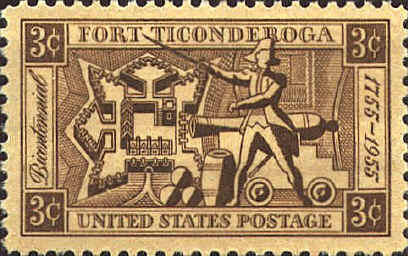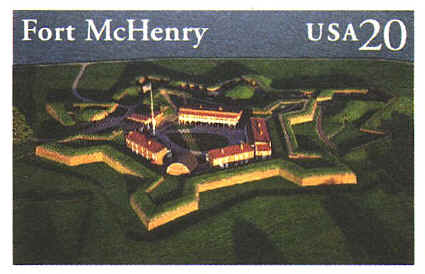|
Fort Ticonderoga ~ 1755
Fort
Carillon was begun by the French in 1755 between Lake George and Lake
Champlain on the Richlieu River. It was based on Vauban's ancient
fortress at Metz in Alsace-Lorraine. The English captured it in 1759,
and renamed it Fort Ticonderoga. Colonel Ethan Allen, said to be
represented by the figure in the design, recaptured the Fort for the
Continental Congress. The stamp commemorates the two hundredth
anniversary of its founding by the French. The image on the
stamp was drawn by Michel Chartier de Lotbiniere for the original
construction of the Fort by the French.

Fort McHenry ~ 1814
Fort
McHenry was originally called Fort Whetstone because of its location
on Whetstone Point near Baltimore, Maryland. It was built in 1799 , on
a century-old French design, star-shaped with five bastions. It was
renamed McHenry for James McHenry, Secretary of War, under George
Washington.
Its major claim to fame is that the battle which
provided the background for the Star Spangled Banner was fought at For
McHenry.
On September 13 1814 the British bombarded the fort for
twenty-four hours during the war of 1812. The fort resisted the attack
and Baltimore was saved. The valiant resistance inspired Francis Scott
Key to write the Star Spangled Banner. This poem, set to the English
song, To Anacreon in Heaven, became or National Anthem by act
of Congress in 1931.
The flag which flew over the fort was made by Mary
Pickersgill of Baltimore. With help from her daughter, Caroline Purdy,
she sewed a woolen flag measuring 42 feet long by 30 feet high with
fifteen stars and fifteen stripes. Francis Scott Key watched the
battle from eight miles below Baltimore where he was detained. He had
negotiated the release of Dr. William Beanes who had been captured by
the British.

 |
